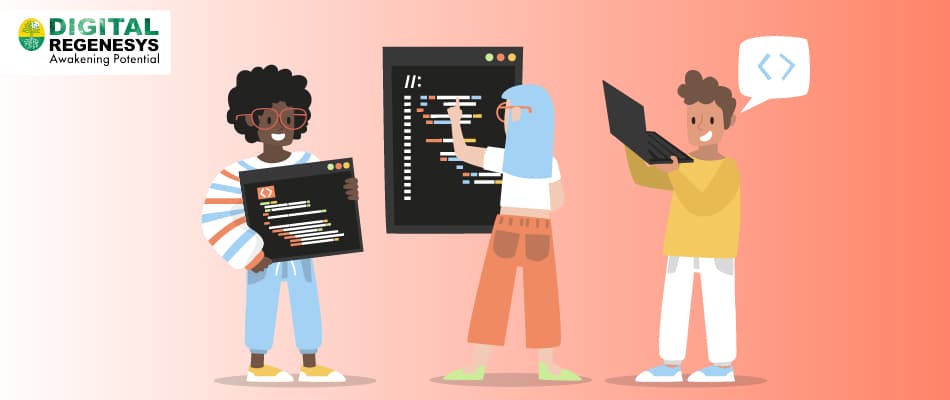How to become a full stack web developer in 2024?
The Full Stack Development career is perfect for those who like designing user interfaces and managing web application databases. This role requires both front-end and back-end development skills. This will help you handle all aspects of web development. To start your career in full-stack development, you first have to learn the basics of HTML, CSS, and JavaScript for front-end development. After that, work on server-side languages such as Node.js, Python, or Ruby, and then learn how to manage databases using SQL or NoSQL databases. Gain practical experience and stay updated with the latest technology tools. Learn more about how to become a full-stack developer in the article below.
What is a Full Stack Developer?
Full-stack Developers work on both the front and back ends of a website or application. The front end is what users see, and the back end is where data is stored and processed. Full-stack Developers use various coding languages and tools to build a website or application. They use HTML, CSS, and JavaScript for the front end and server-side languages like Node.js or Python for the back end. They handle multiple aspects of development, which makes their role valuable in tech projects.
Read more – What is a Full Stack Developer

What Does a Full Stack Developer Do?
Full-stack developers create and manage the front-end and back-end of websites and applications. The front end is the layout and design that users see and interact with. On the other hand, the back end is the server, database, and application where the data is stored. They manage code, create databases, handle servers, and ensure everything works simultaneously. Full-stack developers use different programming languages and tools in the development process. They ensure that websites and apps are functional, user-friendly, and efficient.
How To Become a Full-Stack Developer
To become a full-stack developer, you must know front-end and back-end technologies. After that, try to understand server-side programming and databases to manage web applications. Learn more about how to become a full-stack developer below.
- Start learning courses like HTML, CSS, and JavaScript for front-end development. Learn how to create and design web pages.
- Learn popular frameworks like React, Angular, or Vue.js for dynamic and interactive user interfaces.
- Choose a back-end language such as JavaScript (Node.js), Python (Django or Flask), Ruby (Ruby on Rails), or PHP (Laravel).
- Understand server-side development, databases (SQL or NoSQL), and RESTful APIs.
- Create web applications using your front-end and back-end skills.
- Practise database integration, handle user authentication, and create applications.
- Work on personal projects or practise open-source projects to enhance your skills and portfolio.
Read more – how do i become a full stack developer with no experience
Skills Required to Become a Full-Stack Developer
To become a full-stack developer, you must learn various programming languages and technologies. Moreover, you must have certain skills to analyse data effectively and solve critical problems. Here, we have mentioned those skills that you need to become a full-stack developer.
- Proficiency in creating semantic HTML and designing web applications with CSS.
- JStrong understanding of JavaScript, including ES6+ for dynamic and interactive web applications.
- Experience with popular frameworks like React, Angular, or Vue.js to create strong user interfaces.
- Knowledge of server-side languages and frameworks such as Node.js, Python (Django/Flask), Ruby (Ruby on Rails), or PHP (Laravel) to handle server-side logic and databases.
- Familiarity with MySQL, PostgreSQL and NoSQL databases (e.g., MongoDB) for storing and managing data.
- Proficient in using Git for version control to manage the codebase.
- Understanding how to design, build, and use APIs for smooth communication between front-end and back-end systems.
Read more – What are the requirements to be a full-stack web developer?
Average Salary of Full Stack Developer
The average salary of a full-stack developer is around R600,000 per year. At the entry level, they receive around R360,000. It increases to R7200,000 per year with experience. The salary of a full-stack developer varies based on experience and skills. Here, we have added a table of the cities in South Africa with the highest-paying full-stack developers.
|
Cities |
Salary Range (Per month) |
|
Midrand |
|
|
Sandton |
|
|
Stellenbosch |
|
|
Durban |
|
|
Johannesburg North |
|
Difference Between Full Stack Developer and Full Stack Engineer
Full Stack Developers and Full Stack Engineers have different roles in web development. Both work with front-end and back-end technologies, but their jobs and responsibilities are different. The following table shows the differences between full-stack developers and full-stack engineers.
|
Full Stack Developer |
Full Stack Engineer |
|
1. Focuses on the development of web applications. |
1. Focuses on system design, architecture, and scalability. |
|
2. Write code for the front-end and back-end of an application. |
2. Along with writing, they also plan and manage the overall project development process. |
|
3. They work with technologies like HTML, CSS, JavaScript, and back-end languages like Python, Node.js, or Ruby. |
3. On the other hand, full-stack engineers focus on system architecture, performance optimisation, and scale efficiency of applications. |
|
4. Needs to be proficient in front-end and back-end technologies, databases and version control systems. |
4. Must have a deeper understanding of software engineering, system design, and architecture |
|
5. They should be able to create functional and user-friendly applications. |
5. Efficient in project management, continuous integration and deployment (CI/CD), and advanced problem-solving techniques. |
Read more – what is the difference between a full stack developer and a software engineer
Become a Full Stack Developer with Digital Regenesys Full Stack Development Course
Digital Regenesys’ Full Stack Development Course is a 40-week program. Here, you will learn the essential front-end and back-end development skills. The curriculum includes HTML, CSS, JavaScript, GitHub, databases, Node.js, web security, etc. The course provides live sessions with industry experts and hands-on experience through practical projects. The course also offers international certification, live classes and career counselling. The course is available for students from the USA, South Africa, Nigeria, Kenya, Uganda, Tanzania, and India. You can enrol in the course for just R 29,500 in South Africa. The tools covered in this course are ChatGPT, EXPRESS Js, GitHub, Node, CSS, HTML, JS, and Mongo DB.
Full Stack Developer requires a solid understanding of various programming languages, frameworks, and tools. Digital Regenesys offers a comprehensive curriculum to improve the skills required in this field. Digital Regenesys also offer an online learning approach with the tools required to succeed in the dynamic field of Full Stack Development. After this course, you will be well-prepared to tackle any challenges and contribute effectively to industry demands.
FAQs
1) What is a Full Stack Developer?
A full-stack developer is a programmer who knows front-end and back-end development. He works on user interfaces (HTML, CSS, JavaScript), server-side logic (Node.js, Python) and databases.
2) What skills are required to become a Full Stack Developer?
To become a Full-Stack Developer, you must be efficient in HTML, CSS, JavaScript, server-side languages like Node.js or Python, databases like MySQL or MongoDB, and version control tools like Git.
3) What does a Full Stack Developer do?
Full-stack Developers manage the front end (layout and design) and back end (server, database, application) of websites and applications.
4) What is the average salary of a Full Stack Developer in South Africa?
The average salary of a Full Stack Developer in South Africa is around R600,000 per year, with entry-level positions starting at R360,000 and experienced developers earning up to R720,000 per year.
5) How does Digital Regenesys’ Full Stack Development Course help aspiring developers?
Digital Regenesys’ 40-week Full Stack Development Course covers essential front-end and back-end development skills. It offers live sessions, hands-on projects, international certification, and more.













